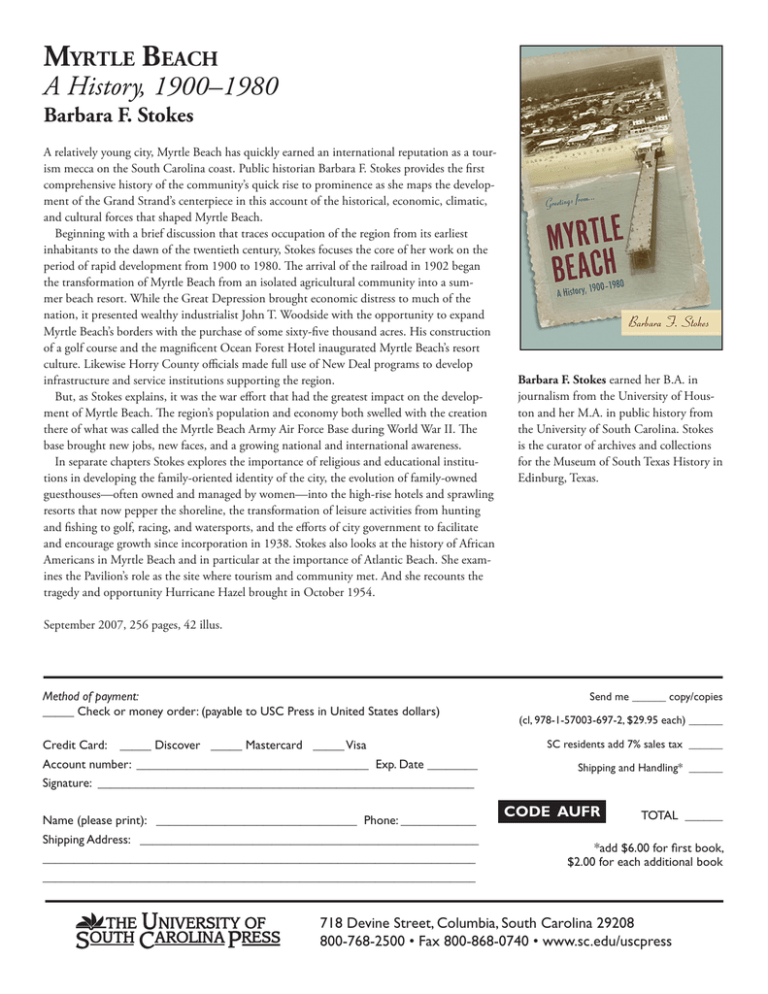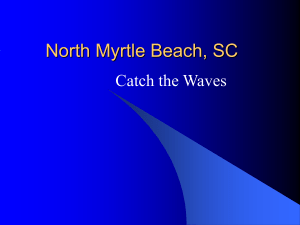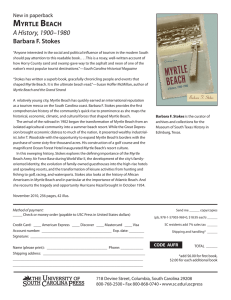M B A History, 1900–1980 yrtle
advertisement

Myrtle Beach A History, 1900–1980 Barbara F. Stokes A relatively young city, Myrtle Beach has quickly earned an international reputation as a tourism mecca on the South Carolina coast. Public historian Barbara F. Stokes provides the first comprehensive history of the community’s quick rise to prominence as she maps the development of the Grand Strand’s centerpiece in this account of the historical, economic, climatic, and cultural forces that shaped Myrtle Beach. Beginning with a brief discussion that traces occupation of the region from its earliest inhabitants to the dawn of the twentieth century, Stokes focuses the core of her work on the period of rapid development from 1900 to 1980. The arrival of the railroad in 1902 began the transformation of Myrtle Beach from an isolated agricultural community into a summer beach resort. While the Great Depression brought economic distress to much of the nation, it presented wealthy industrialist John T. Woodside with the opportunity to expand Myrtle Beach’s borders with the purchase of some sixty-five thousand acres. His construction of a golf course and the magnificent Ocean Forest Hotel inaugurated Myrtle Beach’s resort culture. Likewise Horry County officials made full use of New Deal programs to develop infrastructure and service institutions supporting the region. But, as Stokes explains, it was the war effort that had the greatest impact on the development of Myrtle Beach. The region’s population and economy both swelled with the creation there of what was called the Myrtle Beach Army Air Force Base during World War II. The base brought new jobs, new faces, and a growing national and international awareness. In separate chapters Stokes explores the importance of religious and educational institutions in developing the family-oriented identity of the city, the evolution of family-owned guesthouses—often owned and managed by women—into the high-rise hotels and sprawling resorts that now pepper the shoreline, the transformation of leisure activities from hunting and fishing to golf, racing, and watersports, and the efforts of city government to facilitate and encourage growth since incorporation in 1938. Stokes also looks at the history of African Americans in Myrtle Beach and in particular at the importance of Atlantic Beach. She examines the Pavilion’s role as the site where tourism and community met. And she recounts the tragedy and opportunity Hurricane Hazel brought in October 1954. Barbara F. Stokes earned her B.A. in journalism from the University of Houston and her M.A. in public history from the University of South Carolina. Stokes is the curator of archives and collections for the Museum of South Texas History in Edinburg, Texas. September 2007, 256 pages, 42 illus. Method of payment: _____ Check or money order: (payable to USC Press in United States dollars) Credit Card: _____ Discover _____ Mastercard _____ Visa Account number: _____________________________________ Exp. Date ________ Signature: ____________________________________________________________ Name (please print): ________________________________ Phone: ____________ Shipping Address: ______________________________________________________ _____________________________________________________________________ _____________________________________________________________________ Send me ______ copy/copies (cl, 978-1-57003-697-2, $29.95 each) ______ SC residents add 7% sales tax ______ Shipping and Handling* ______ CODE AUFR TOTAL ______ *add $6.00 for first book, $2.00 for each additional book 718 Devine Street, Columbia, South Carolina 29208 800-768-2500 • Fax 800-868-0740 • www.sc.edu/uscpress


